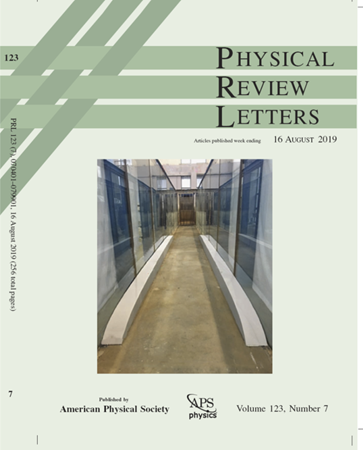黑洞-中子星合并喷射中的锕系元素增强过程
IF 9
1区 物理与天体物理
Q1 PHYSICS, MULTIDISCIPLINARY
引用次数: 0
摘要
我们首次基于长期中微子辐射-磁流体动力学模拟的结果,研究了黑洞-中子星合并抛射物中的核合成。我们发现,动态和合并后的喷射结合再现了一个类似太阳的r过程模式。此外,锕系元素的增强水平对电子分数的分布和动力学喷射速度都高度敏感。我们的结果表明,为了使核合成丰度与r-过程增强的锕系元素助推恒星的核合成丰度相一致,动态抛射的平均电子分数应该为> 0.05。由于潮汐抛射保留了预合并中子星内部地壳中的中子丰富度,如果黑洞-中子星合并导致锕系元素助推星,则该结果为核状态方程提供了重要的约束。2024年由美国物理学会出版本文章由计算机程序翻译,如有差异,请以英文原文为准。
Actinide-Boosting r Process in Black-Hole–Neutron-Star Merger Ejecta
We examine nucleosynthesis in the ejecta of black-hole–neutron-star mergers based on the results of long-term neutrino-radiation-magnetohydrodynamics simulations for the first time. We find that the combination of dynamical and postmerger ejecta reproduces a solarlike r-process pattern. Moreover, the enhancement level of actinides is highly sensitive to the distribution of both the electron fraction and the velocity of the dynamical ejecta. Our result implies that the mean electron fraction of dynamical ejecta should be ≳ 0.05 r Published by the American Physical Society 2024
求助全文
通过发布文献求助,成功后即可免费获取论文全文。
去求助
来源期刊

Physical review letters
物理-物理:综合
CiteScore
16.50
自引率
7.00%
发文量
2673
审稿时长
2.2 months
期刊介绍:
Physical review letters(PRL)covers the full range of applied, fundamental, and interdisciplinary physics research topics:
General physics, including statistical and quantum mechanics and quantum information
Gravitation, astrophysics, and cosmology
Elementary particles and fields
Nuclear physics
Atomic, molecular, and optical physics
Nonlinear dynamics, fluid dynamics, and classical optics
Plasma and beam physics
Condensed matter and materials physics
Polymers, soft matter, biological, climate and interdisciplinary physics, including networks
 求助内容:
求助内容: 应助结果提醒方式:
应助结果提醒方式:


